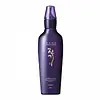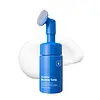What's inside
What's inside
 Key Ingredients
Key Ingredients

 Benefits
Benefits

 Concerns
Concerns

 Ingredients Side-by-side
Ingredients Side-by-side

Water
Skin ConditioningAlcohol
AntimicrobialButylene Glycol
HumectantCnidium Officinale Root Extract
Skin ConditioningArtemisia Princeps Leaf Extract
Skin ConditioningCamellia Sinensis Leaf Extract
AntimicrobialAngelica Acutiloba Root Extract
Skin ConditioningPEG-60 Hydrogenated Castor Oil
EmulsifyingPropylene Glycol
HumectantMenthol
MaskingSalicylic Acid
MaskingPanthenol
Skin ConditioningXanthan Gum
EmulsifyingTriethanolamine
BufferingAllantoin
Skin ConditioningDisodium EDTA
Glycyrrhiza Glabra Root Extract
BleachingPolygonum Multiflorum Root Extract
Skin ConditioningAcorus Calamus Root Extract
PerfumingCapsicum Annuum Fruit Extract
AntimicrobialDipropylene Glycol
HumectantPanax Ginseng Root Extract
Emollient1,2-Hexanediol
Skin ConditioningPhenoxyethanol
PreservativeWater, Alcohol, Butylene Glycol, Cnidium Officinale Root Extract, Artemisia Princeps Leaf Extract, Camellia Sinensis Leaf Extract, Angelica Acutiloba Root Extract, PEG-60 Hydrogenated Castor Oil, Propylene Glycol, Menthol, Salicylic Acid, Panthenol, Xanthan Gum, Triethanolamine, Allantoin, Disodium EDTA, Glycyrrhiza Glabra Root Extract, Polygonum Multiflorum Root Extract, Acorus Calamus Root Extract, Capsicum Annuum Fruit Extract, Dipropylene Glycol, Panax Ginseng Root Extract, 1,2-Hexanediol, Phenoxyethanol
Sea Water
HumectantAlcohol Denat.
AntimicrobialButylene Glycol
Humectant1,2-Hexanediol
Skin ConditioningWater
Skin ConditioningC12-14 Alketh-12
EmulsifyingSodium Citrate
BufferingCaprylyl Glycol
EmollientMenthol
MaskingPolysorbate 20
EmulsifyingParfum
MaskingSalicylic Acid
MaskingPanthenol
Skin ConditioningCocodimonium Hydroxypropyl Hydrolyzed Wheat Protein
CleansingAllantoin
Skin ConditioningDipotassium Glycyrrhizate
HumectantPiroctone Olamine
PreservativeDisodium EDTA
Prunus Mume Fruit Extract
HumectantCarica Papaya Fruit Extract
Skin ConditioningVitis Vinifera Fruit Extract
Skin ConditioningPyrus Malus Fruit Extract
Skin ConditioningPinus Palustris Leaf Extract
TonicPueraria Lobata Root Extract
HumectantUlmus Davidiana Root Extract
Skin ConditioningOenothera Biennis Flower Extract
AstringentGlutamine
Skin ConditioningLysine Hcl
Skin ConditioningTryptophan
MaskingSerine
MaskingPhenylalanine
MaskingOrnithine
Skin ConditioningMethionine
Skin ConditioningArginine Hcl
Skin ConditioningLeucine
Skin ConditioningThreonine
Tyrosine
MaskingGlycine
BufferingValine
MaskingCarnitine
CleansingProline
Skin ConditioningHistidine Hcl
Skin ConditioningGlutamic Acid
HumectantCitrulline
Skin ConditioningCysteine Hcl
AntioxidantAlanine
MaskingIsoleucine
Skin ConditioningAspartic Acid
MaskingSea Water, Alcohol Denat., Butylene Glycol, 1,2-Hexanediol, Water, C12-14 Alketh-12, Sodium Citrate, Caprylyl Glycol, Menthol, Polysorbate 20, Parfum, Salicylic Acid, Panthenol, Cocodimonium Hydroxypropyl Hydrolyzed Wheat Protein, Allantoin, Dipotassium Glycyrrhizate, Piroctone Olamine, Disodium EDTA, Prunus Mume Fruit Extract, Carica Papaya Fruit Extract, Vitis Vinifera Fruit Extract, Pyrus Malus Fruit Extract, Pinus Palustris Leaf Extract, Pueraria Lobata Root Extract, Ulmus Davidiana Root Extract, Oenothera Biennis Flower Extract, Glutamine, Lysine Hcl, Tryptophan, Serine, Phenylalanine, Ornithine, Methionine, Arginine Hcl, Leucine, Threonine, Tyrosine, Glycine, Valine, Carnitine, Proline, Histidine Hcl, Glutamic Acid, Citrulline, Cysteine Hcl, Alanine, Isoleucine, Aspartic Acid
Ingredients Explained
These ingredients are found in both products.
Ingredients higher up in an ingredient list are typically present in a larger amount.
1,2-Hexanediol is a synthetic liquid and another multi-functional powerhouse.
It is a:
- Humectant, drawing moisture into the skin
- Emollient, helping to soften skin
- Solvent, dispersing and stabilizing formulas
- Preservative booster, enhancing the antimicrobial activity of other preservatives
Allantoin is a soothing ingredient known for its protective and moisturizingg properties. Because of this, it is often added to products with strong active ingredients.
Studies show higher concentrations of this ingredient can promote wound healing.
Though it can be derived from the comfrey plant, allantoin is produced synthetically for cosmetic products to ensure purity.
Learn more about AllantoinButylene Glycol (or BG) is used within cosmetic products for a few different reasons:
Overall, Butylene Glycol is a safe and well-rounded ingredient that works well with other ingredients.
Though this ingredient works well with most skin types, some people with sensitive skin may experience a reaction such as allergic rashes, closed comedones, or itchiness.
Learn more about Butylene GlycolDisodium EDTA plays a role in making products more stable by aiding other preservatives.
It is a chelating agent, meaning it neutralizes metal ions that may be found in a product.
Disodium EDTA is a salt of edetic acid and is found to be safe in cosmetic ingredients.
Learn more about Disodium EDTAMenthol is a compound found in mint plants, such as peppermint. In its pure form, it is a clear crystalline substance.
Menthol is known for its cooling sensation; however, the cooling is actually from your skin being sensitized. Menthol can worsen rosacea. We recommend speaking with a professional if you have concerns.
Menthol also has antimicrobial properties.
Learn more about MentholPanthenol is a common ingredient that helps hydrate and soothe the skin. It is found naturally in our skin and hair.
There are two forms of panthenol: D and L.
D-panthenol is also known as dexpanthenol. Most cosmetics use dexpanthenol or a mixture of D and L-panthenol.
Panthenol is famous due to its ability to go deeper into the skin's layers. Using this ingredient has numerous pros (and no cons):
Like hyaluronic acid, panthenol is a humectant. Humectants are able to bind and hold large amounts of water to keep skin hydrated.
This ingredient works well for wound healing. It works by increasing tissue in the wound and helps close open wounds.
Once oxidized, panthenol converts to pantothenic acid. Panthothenic acid is found in all living cells.
This ingredient is also referred to as pro-vitamin B5.
Learn more about PanthenolSalicylic Acid (also known as beta hydroxy acid or BHA) is a well-known ingredient for treating skin that struggles with acne and clogged pores. It exfoliates both the skin's surface and deep within the pores to help clear out buildup, control oil, and reduce inflammation.
Unlike AHAs (alpha hydroxy acids), salicylic acid is oil-soluble. This allows it to penetrate into pores which makes it especially effective for treating blackheads and preventing future breakouts.
Salicylic acid is also known for its soothing properties. It has a similar structure to aspirin and can calm inflamed or irritated skin, making it a good option for acne-prone skin that is also sensitive.
Concentrations of 0.5-2% are recognized by the U.S. FDA as an over-the-counter topical acne product.
It can cause irritation and/or dryness if one's skin already has a compromised moisture barrier, so it's best to focus on repairing that before introducing this ingredient into your routine.
While salicylic acid does not increase sun sensitivity, it’s still important to wear sunscreen daily to protect your skin.
If you are looking for the ingredient called BHA or Butylated Hydroxyanisole, click here.
Learn more about Salicylic AcidWater. It's the most common cosmetic ingredient of all. You'll usually see it at the top of ingredient lists, meaning that it makes up the largest part of the product.
So why is it so popular? Water most often acts as a solvent - this means that it helps dissolve other ingredients into the formulation.
You'll also recognize water as that liquid we all need to stay alive. If you see this, drink a glass of water. Stay hydrated!
Learn more about Water